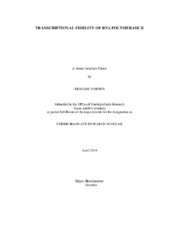| dc.description.abstract | This research aims to elucidate possible genes that affect transcriptional fidelity of RNA polymerase II (pol II) and quantify these affects in vivo. The main focus of this project is the small nonessential subunit of RNA pol II, Rpb9, which is needed for accurate transcription, and the potential proteins the subunit interacts with. Possible gene candidates were selected based on synthetic lethality when they are simultaneously deleted with RPB9 or by their ability to suppress mutations in RPB9. An in vivo assay in Saccharomyces cerevisiae, used for this project, takes advantage of the transposable element Ty1. RNA transcribed from Ty1 DNA encodes a reverse transcriptase that copies the RNA into DNA and allows it to randomly insert into a host cell chromosome. Errors that occur during transcription of Ty1 RNA become permanent changes in the inserted chromosomal DNA that can be identified and counted. This research is only a small part of a much larger objective that attempts to explain the molecular mechanisms by which the cell maintains the fidelity of transcription. Maintaining fidelity is critical for cells; with poor fidelity RNA pol II would transcribe a "faulty" message, leading to the translation of a mutated or nonfunctioning protein which could disrupt normal cellular functions. This can be seen in transcriptional mutagenesis in which certain types of DNA damage result in misincorporation of nucleotides rather than transcriptional arrest. Another example of the importance of fidelity is molecular misreadings in which transcription errors, particularly insertions that cause frameshifts, have been implicated in age related diseases such as Alzheimer's. The preliminary results of this research have shown that this in vivo fidelity assay provides a valid way to quantify the effects of specific gene deletions on transcriptional fidelity. Proteins that were initially investigated were ones associated with RNA pol II: TFIIS (DST1) and the SAGA complex (SPT7). Preliminary experiments strongly suggested that TFIIS was not essential for RNA pol II fidelity. These experiments showed that wild type and dst1- cells each had indistinguishable error frequencies. These data are consistent with experiments conducted by Dr. Peterson using a different in vivo assay; however it contradicts a commonly held notion regarding TFIIS involvement in fidelity. This research is now currently constructing new yeast strains with the correct alleles need for the in vivo fidelity assay. Also, a strain containing a 1-59 amino acid deletion on Rpb9 has been created and is almost ready to test in the fidelity assay. | en |


